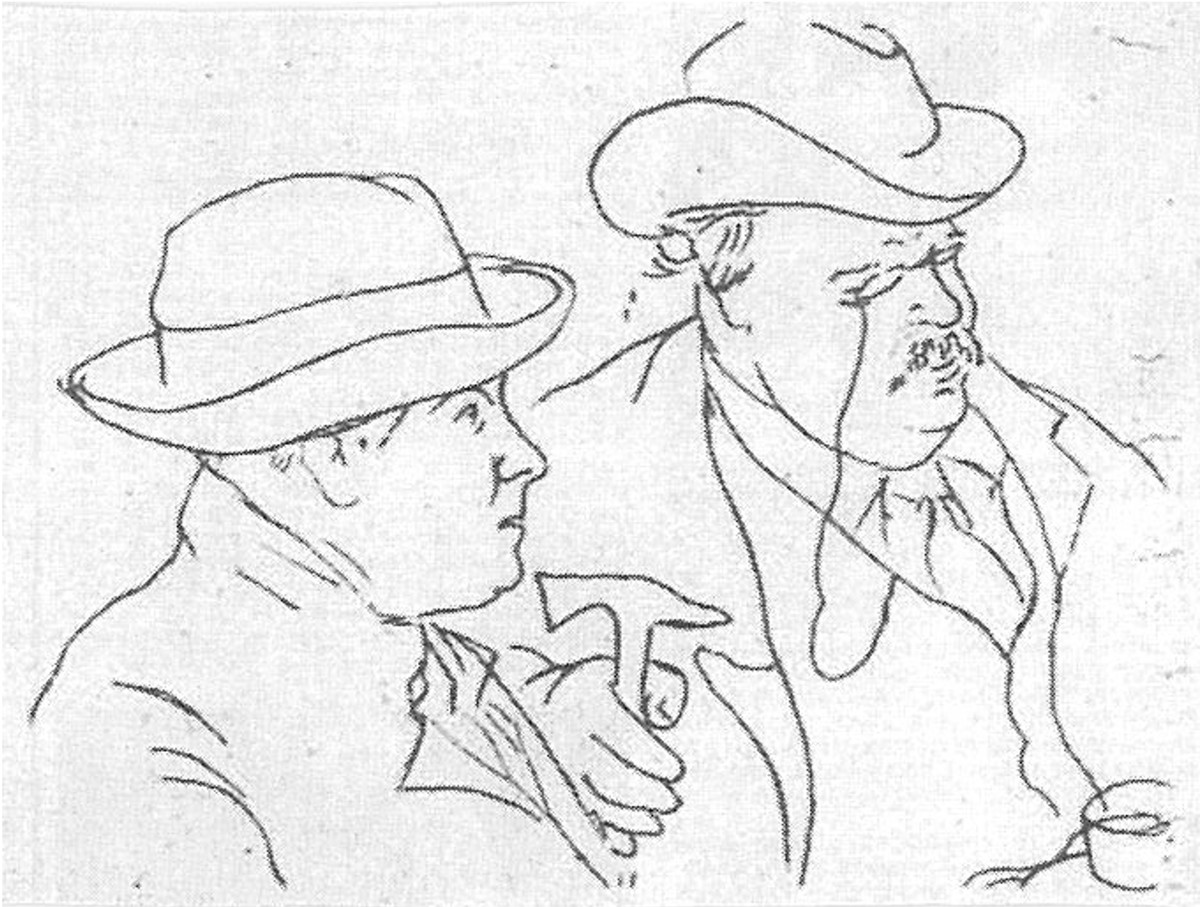Chesterton in Catalonia
Gilbert and Frances stayed twice in Catalonia: the first time in May 1926 and the second one in 1935, also during the spring.
Period before his 1926 stay
Chesterton began to be known in Catalonia during the years of the First World War, as a controversial journalist active in the Allied cause through his weekly column in the Illustrated London News, and then, soon after, for his position on the Irish question. In the weekly magazine Iberia, published in Barcelona, Antoni Rovira i Virgili echoed his commitment to the Allies, and in La Revista Josep M. López-Picó published anti-German and Irish-related articles by Chesterton, going on to assign him a chapter of the booklet Escriptors estrangers contemporanis (1918). There was a first attempt to invite him by the Catalan section of the PEN club in the spring of 1924.
1926 stay

J. M. Junoy i G. K. Chesterton (E. C. Ricart)
Chesterton’s first stay in Catalonia took place in May and early June 1926, to the invitation of the Catalan section of the PEN club, accompanied by his wife and his niece, Rodha Bastable and hosted by the poet and writer Josep M. Junoy. Chesterton stayed at the Hotel Majestic on the Passeig de Gràcia and was very well received by the press and the local writers, who paid tribute to him in a dinner at the Hotel Ritz. While they were dining, Josep M. de Sagarra drew a brilliant portrait of him. Chesterton gave a lecture at the Literary University of Barcelona; was often seen walking down the Rambla, always with a bunch of newspapers under his arm; and he visited the Ateneu Barcelonès and the American Library on the old passage of La Virreina. He took the opportunity to have a brief stay in Sitges and to visit Vilanova i la Geltrú and Tarragona.
Period in between visits (1926-1935)
It was during these years when Chesterton’s outreach in Catalonia was greater, as a result, in part, of his first stay. With the encouragement of Josep M. Junoy –host of his first visit– and counting on the active participation of Pau Romeva, a campaign towards “chestertonization” is undertaken from the pages of La Nova Revista, through a section in the magazine dedicated to the “Amics de Chesterton” (“Friends of Chesterton”) and the project of translating his works into Catalan. The Catholic newspaper El Matí, in which Pau Romeva circulated Chesterton’s social doctrine of distributism, carried on with this task. The Everlasting Man (L’home perdurable, translated by Marià Manent in 1927), Heretics (Herètics, 1928) and What’s Wrong with the World (Allò que no està bé, 1929), translated by Pau Romeva, were published in Catalan. To pay tribute to him after his death in 1936, The Man Who Was Thursday was serialised in Revista de Catalunya and then published in the Quaderns Literaris (translated by Pau Romeva). The outbreak of the civil war and the Francoist dictatorship put an end to the project of dissemination of Chesterton’s work in Catalan.
1935 stay
Chesterton’s second stay in Sitges took place in the spring of 1935. Chesterton had to attend a lecture during the Maggio Florentino, in Tuscany’s capital. Frances and Gilbert took advantage of the trip by car, which was driven by Dorothy Collins, to relax for a few days on the Catalan coast. After crossing the border and passing through Girona and then Barcelona, they decided to settle in Sitges. They stayed at the former Hotel Subur. The sunny Mediterranean climate helped Frances’s fragile health and Gilbert had the opportunity to take a break from his work as director of G. K.’s Weekly, his press contributions and his numerous public commitments. They resumed their trip to Italy via the French Côte d’Azur.
Civil war and Francoist dictatorship (1936-1976)
During the dictatorship the editions in Spanish of Chesterton’s work were resumed thanks to the effort of Josep Janés, who published in “Los clásicos del siglo XX” (“The classics of the 20th century”) the Obras Completas (Complete Works) in one volume (in fact it was a selection of works, carried out with the help of several translators). Under the pseudonym Ramón Setantí, Maurici Serrahima published a wonderful selection of Chesterton texts in 1941, also in Janés (“Las Quintaesencias”), preceded by an introduction in which he glosses Chesterton’s figure, thinking and stimulating style and the organic character of his work. In 1974, on the occasion of the centenary of his birth, the psychiatrist Dídac Parellada published a Recordatori a Chesterton (Memorial of Chesterton, in Pòrtic, with a preface by Octavi Saltor) and Jordi Galí published El compromís polític dels germans Chesterton (The political commitment of the Chesterton brothers, Nova Terra).
From the transition to democracy onwards (1975-2019)
The translation of Chesterton’s works, especially into Spanish, has increased substantially during this period on the initiative of Jaume Vallcorba, who has published in Acantilado his non-fiction work, starting with the Autobiografía (Autobiography, translated by Olivia de Miguel; 2005 Ángel Crespo Prize in translation), of which eight editions have been published so far; Pau Romeva’s translation of L’Home que fou dijous (The Man Who Was Thursday, 2005) was recovered for Quaderns Crema. Other Catalan and Valencian publishers have joined in the popularization of his fiction work (Bromera, Laertes) and essays (Pagès; Viena-Fundació Joan Maragall has published a selection of texts), up to the recent publication of Chesterton’s first known novel, The Napoleon of Notting Hill (Univers, 2019; translated by Josep Pelfort with a preface by David Fernàndez).
